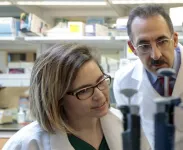Stem cells use a piston-like engine to 'drive' to their destinations
Researchers have discovered the surprising propulsion system that enables these regenerative cells to migrate through surrounding tissue to repair damage.
2021-01-11
(Press-News.org) Our bodies often dispatch stem cells to mend or replace biological damage, but how these repair agents make their way through dense tissue to arrive at the scene had been a mystery. "How stem cells squeeze through tissue openings a hundred to a thousand times smaller than themselves had been a perplexing question," says Ovijit Chaudhuri, professor of mechanical engineering.
In an article published in the Jan. 8 edition of Science Advances, Chaudhuri and colleagues reveal that stem cells use their nucleus - a large, stiff organelle within the cell - as a means of propulsion.
Their discovery was surprising because scientists had thought cells would have particular difficulty forcing this big, stiff lump through tiny pores in surrounding tissue. Instead, they found that bone-marrow derived stem cells use the physical force generated by the nucleus to help bore through biological obstacles to reach fractures and help initiate healing. "Our finding presents a completely new understanding of how cells utilize the nucleus to generate mechanical force," says Hong-Pyo Lee, the study's first author, who recently graduated as a PhD student in mechanical engineering.
To arrive at this finding, the researchers extracted stem cells from bone marrow and used hydrogels to mimic the tissues that compose their biological environments. The researchers found that stem cells propel their nucleus into a needle-like protrusion that penetrates the physical barriers inside the body. The nucleus moves into the protrusion and, through a complex biochemical mechanism, inflates the protrusion like a balloon, creating an opening in the tissue wide enough for the entire stem cell to migrate through. The piston-like behavior of the nucleus, Chaudhuri says, is reminiscent of the action of a mechanical piston within the internal combustion engine of a car.
Their insight could help guide the design of biomaterial implants that would use stem cells for regenerative medicine. Chaudhuri notes that other stem cells, immune cells and cancer cells also migrate through surrounding tissue, suggesting fruitful areas for future research into whether these cells use the same propulsion system, knowledge that might be turned to therapeutic advantage.
"This is a beautiful example of how the principles of mechanical engineering can help us understand cellular behavior that affects health," he says.
INFORMATION:
Ovijit Chaudhuri is an associate professor of mechanical engineering, member of Stanford Bio-X and faculty fellow of Stanford ChEM-H. Hong-Pyo Lee is co-founder of MEDIC Life Sciences. Other authors include Julie Chang and Kolade Adebowale of Stanford University, and Professor Vivek Shenoy and Dr. Farid Alisafaei of the University of Pennsylvania.
The work was funded by a CAREER award from the National Science Foundation to Chaudhuri.
[Attachments] See images for this press release:

ELSE PRESS RELEASES FROM THIS DATE:
2021-01-11
(St. Louis) - A new study by investigators at the Shriners Hospital for Children -- St. Louis suggests the damaging effects of obesity are not due to body weight but rather come from something much smaller - biochemical signals released by fat cells.
The study focuses on the link between overweight or obesity and the development of osteoarthritis, a painful disease of the joints. The investigation was led by Dr. Farshid Guilak, director of the St. Louis Shriners Hospital Research Center.
"We've shown here that it's not overloading of the joints that is responsible for osteoarthritis, but, more likely, a factor given off by fat cells that makes cartilage susceptible to degeneration," ...
2021-01-11
ATLANTA AND TAMPA, FLA. - JANUARY 11, 2021 - A new study suggests a link between toxoplasma gondii (T. gondii) infection and the risk of glioma, a type of brain cancer, in adults. The report, appearing in the International Journal of Cancer, finds that people who have glioma are more likely to have antibodies to T. gondii (indicating that they have had a previous infection) than a similar group that was cancer free.
For the study, investigators led by James Hodge, JD, MPH and Anna Coghill, PhD examined the association between T. gondii antibodies measured several years before the cancer ...
2021-01-11
Scientists at Dana-Farber Cancer Institute and the Centers for Disease Control and Prevention have uncovered new evidence of the potential health risks of chemicals in tobacco and marijuana smoke.
In a study published online today by END ...
2021-01-11
Around 1085 AD, along the southern rim of Northern Arizona's elevated Colorado Plateau, a volcano erupted, forever changing ancient Puebloan fortunes and all nearby life. Among the 600 or so volcanoes that dot the landscape of the San Francisco volcanic fields, this one blew. It was the very first (and last) eruption for what came to be known as Sunset Crater, aptly named for its multi-hued, 1,000-foot-tall cinder cone.
Today, ASU School of Earth and Space Exploration scientist Amanda Clarke and her team have been working to solve the mysterious root cause of the Sunset Crater eruption and any lessons learned to better understand the threats similar ...
2021-01-11
Fieldwork led by Dr Eleanor Scerri, head of the Pan-African Evolution Research Group at the Max Planck Institute for the Science of Human History in Germany and Dr Khady Niang of the University of Cheikh Anta Diop in Senegal, has documented the youngest known occurrence of the Middle Stone Age. This repertoire of stone flaking methods and the resulting tools includes distinctive ways of producing sharp flakes by carefully preparing nodules of rock, some of which were sometimes further shaped into tool forms known as 'scrapers' and 'points.' Middle Stone Age finds most commonly occur in the African record between around 300 thousand and 30 thousand years ago, after which point ...
2021-01-11
Researchers have taken an important step forward in developing a controlled human infection model to test leishmaniasis vaccines.
The University of York-led study identified and characterised a new strain of Leishmania parasite that will form the basis of a new controlled human infection model for the disease which is transmitted by the bite of sand flies. The team then produced the parasite to the standards required for use in human clinical studies.
The use of controlled human infection models has already proved invaluable in accelerating vaccine development for cholera, malaria, typhoid, ...
2021-01-11
Conditions are ripe for transforming the U.S. mental health care system, with scientific advances, the growth of Medicaid and political consensus on the importance of improving mental health creating the possibility that goals once thought out of reach may be possible, according to a new RAND Corporation study.
Broad changes will be needed to improve how Americans receive mental health care, such as integrating behavioral health care into general health care settings, providing supportive housing to the homeless and promoting comprehensive mental health education.
Federal mental health parity legislation is one recent promising development that aims to put ...
2021-01-11
Human papillomavirus (HPV) can infect the mouth and throat to cause cancers of the oropharynx. A new study published early online in END ...
2021-01-11
Canada must dismantle anti-Black racism in health care to address its harmful effects on people's health, argue authors of a commentary in CMAJ (Canadian Medical Association Journal)
http://www.cmaj.ca/lookup/doi/10.1503/cmaj.201579
Racism has significant negative effects on the physical and mental health of Black people and people of nondominant racial groups. For example, there have been significantly higher death rates from COVID-19 among Black people in North America and the United Kingdom. Anti-Black racism also exists in the medical system, with stereotyping and bias by health care providers and an underrepresentation of Black physicians.
"First, we who work in health care must acknowledge the existence of anti-Black racism in ...
2021-01-11
An analysis of a large nationally representative longitudinal study by University of California San Diego Herbert Wertheim School of Public Health and Human Longevity Science report that starting tobacco products, including e-cigarettes, before the age of 18 is a major risk factor for people becoming daily cigarette smokers.
Reporting in the January 11, 2021 online edition of Pediatrics, researchers found that in 2014 people age 12 to 24 who used e-cigarettes were three times as likely to become daily cigarette smokers in the future. Among those who reported using a tobacco product, daily use increased with age through age 28. Daily cigarette smoking nearly doubled between 18 to 21 year olds (12 percent) and 25 to 28 year ...
LAST 30 PRESS RELEASES:
[Press-News.org] Stem cells use a piston-like engine to 'drive' to their destinations
Researchers have discovered the surprising propulsion system that enables these regenerative cells to migrate through surrounding tissue to repair damage.




